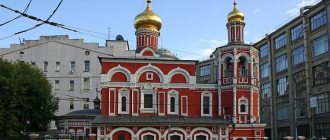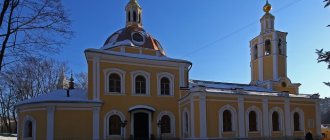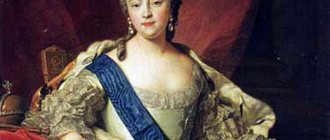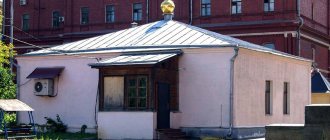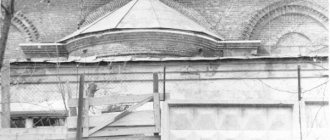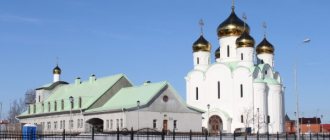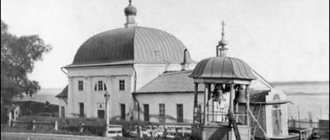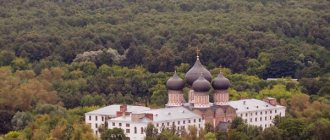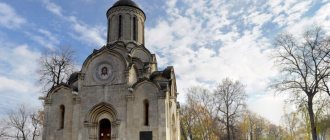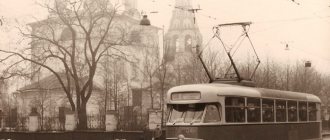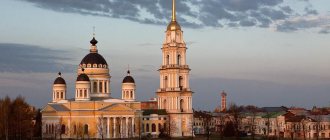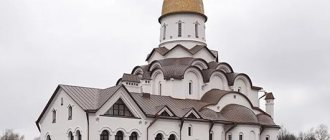| Moscow All Saints Church on Kulishki, 2006. Photo by Mikhail Chuprinin from the site sobory.ru |
Moscow Church in honor of All Saints on Kulishki
, metochion of the Alexandrian Orthodox Church
- Address: Russia, 109074, Moscow, Slavyanskaya Square, 2. Metro “Kitay-Gorod”
- Telephone. Fax
- Official site:
- On the map: Yandex.Map, Google map
According to legend, the temple was built by Grand Duke Dimitri Donskoy: having returned victorious from the Battle of Kulikovo in 1380, he immediately ordered the construction of a temple in memory of the Russian soldiers who died on the battlefield.
However, there is another version of historians, according to which the temple appeared on this site long before 1380. Sometimes the exact date is given - around 1367, that is, also during the reign of Donskoy, only much earlier than the Battle of Kulikovo. And the original foundation of the temple here is associated with the development and settlement of this area near the Moscow suburb. It is believed that in ancient times this place was inconvenient and unsuitable for settlement, as evidenced by its very name - “Kulishki” or “Kulizhki”, which is still a mystery for historians and Muscovites. One interpretation of the word “kulishki” defines it as a marshy, swampy place, or a wetland. There is a legend that once upon a time there really was a swamp here, where waders lived - birds that live in swampy areas. It is known that in ancient times the Kulishki area had large borders and extended higher - to Ivanovskaya Gorka and beyond. Scientists believe that at the dawn of Moscow history there was a dense forest here, and therefore “kulishki” can mean cleared areas of land or cleared clearings among the forest. One of the local churches in the name of John the Baptist was then called “that under the forest.” In the 15th century, this forest was replaced by the luxurious Sovereign Gardens, which left a memory in the name of Starosadsky Lane adjacent to Kulishki. Also, kulizhki (kuligami) in the Old Russian language were the names of plots of land along the banks of rivers, near bends, which were used for haymaking. There is an opinion that “kulishki” comes from the word “kulki” or “purses” - they have been abundant here for a long time, which is why the neighboring area, now known as the Yauz Gate, was called Kosheli in the old days. Finally, the most unconvincing, but historically justified version of the meaning of the word “kulishki” dates its origin to the times of Dmitry Donskoy himself and the Battle of Kulikovo. From the name of the area where the glorious battle of the Russian army took place - the Kulikovo Field - the name of the Moscow Kulishki came from, since the Grand Duke passed here twice with his army - going from the Kremlin to the battle and returning to Moscow with victory. Then he ordered to build a wooden church here in the name of All Saints in memory of the fallen Russian soldiers and to call this area “Kulishki” in honor of the Battle of Kulikovo.
The Kulishki area has been reliably known since the 14th century, but it began to be developed long before the Battle of Kulikovo. At that time, this area was already adjacent to the Moscow suburb, which extended from the eastern wall of the Kremlin and Red Square. Hence the opinion of historians that the first church stood here since ancient times, when the first settlements appeared in Kulishki. For a few local residents, it could have been an ordinary parish church. And in 1380, Prince Dmitry Donskoy ordered it to be restored or rebuilt in honor of the victory and the slain soldiers - as a memorial temple.
Written sources mention the All Saints Church since 1488, and on a very sad occasion. When describing the strongest fire in Moscow, the chronicler writes: “...at the ninth hour of the day the Church of the Annunciation on the Swamp caught fire, and therefore it burned from the city to Kulishka, not far from All Saints...”.
The wooden temple burned repeatedly in fires in 1493 and 1547.
During the fighting in 1612, the temple was badly damaged. Next to him stood the cannons of the people's militia.
| Moscow All Saints Church on Kulishki, 1882. From Naydenov's album |
In the first half of the 17th century, the temple was a single-apse cubic volume, surrounded on three sides by a gallery on basements.
In 1662, a small Nikolsky chapel was added to its southeastern part. The chapel of the prophet Nahum, which previously existed at the temple, was located in the southern part of the main altar. After the fire of 1688, the damaged vault and the head of the quadrangle were rebuilt, the windows were cleared, and the refectory and bell tower were added. At the same time, the upper tier of the gallery was dismantled, and the lower one was included in the volume of the basement of the refectory part. After the fire of 1737, the remains of the gallery were laid down and the refectory was rebuilt. During the 17th-19th centuries, the temple was renovated several times. According to the Clergy Gazette of the 18th century, the church was described as follows: “Ivanovo forty (deanery) parish church in the name of All Saints, in Kulishki, stone, solid, with two chapels of St. Nicholas the Wonderworker and the Prophet Nahum, with sufficient utensils.”
In 1931 the temple was closed. The building was transferred to various institutions.
In the 1950s, the All Saints Church was renovated from the outside. In 1967, the construction and installation department was located inside the temple. In the 1970s, the temple was completely restored from the outside and in the 1970s-1980s it was given over to the Touring Bureau of the Mosconcert branch. Another restoration was carried out on the outside, which was completed by 1982. In 1990, the internal renovation of the temple was carried out and given to the Museum of History and Reconstruction of Moscow. Many fragments of paintings were revealed on the walls.
At the end of 1991, the temple was returned to the Church.
On April 24, 1999, the grand opening of the courtyard of the Alexandria Church took place at the All Saints Church.
In 2002-2003 The dilapidated building of the clergy house was completely renovated, lined with brickwork and covered with metal tiles. In 2004, from a two-story building located near the clergy house and a two-story building in disrepair, a wonderful two-story building of the bishop's house was built. In 2006, a new two-story building was built on the empty space of the church yard, and in 2008, it was successfully rebuilt; the first floor of which is the office part and the reception room of the metropolitan, and on the second floor there are rest rooms for the clergy of the metochion.
In 2007, the temple building was completely renovated from the outside, the facade was restored with partial replacement of the brickwork. The newly painted red-brick church building acquired its original, historically accurate white-red color scheme of the 17th century, and the domes and roof of the church were re-covered with copper sheets. In the same year, the asphalt surface of the courtyard around the temple was replaced with stone paving stones.
In 2009-2010, the limestone foundation, which had become damp over the years, was completely replaced with monolithic concrete installed on reinforced concrete tubular piles sunk into the ground by jacks. A monolithic reinforced concrete slab was placed under the first, lower tier of the temple, which over the years ended up underground. The technical basement was restored between the monolithic slab and the reinforced concrete foundation. Thus, it was possible to stop the formation of cracks in the load-bearing walls of the temple and prevent the possible destruction of the bell tower, which had leaned over time.
The existing building dates from the 16th century and may have incorporated parts of an earlier stone structure. On the western side of the All Saints Church, a cast-iron porch from the 19th century has been preserved. Over the centuries-long history of its existence, the All Saints Church sunk 3.5 meters into the ground and its bell tower tilted slightly, becoming another “Leaning Tower of Pisa” in Moscow.
How to get there
- Metro. The church is located above the exit from the Kitay-gorod station of the Tagansko-Krasnopresnenskaya line.
- Walking from Red Square. Walk 830m east from St. Basil's Cathedral. Moving along Varvarka Street, cross Old Square and walk to the second building on the right side.
- By car. From the inside of the Garden Ring, move in the direction of Kitay-Gorod. On the south side - along Kitaygorodsky Proezd, to Slavyanskaya Square. From the north side, go down Lubyansky Proezd. Also, the mentioned roads are used when approaching from the eastern and western sides.
- Bus routes No. 38, 101, 144, 158, 904, m7, m7k, m2, m8, m9, m10, to the Kitay-Gorod metro station stop.
Location and ways to get there
The church is located in the center of Moscow near the Kitay-Gorod metro stop. Address - Slavyanskaya Square, building 2.
You can get to the temple:
- By car - along the inner side of the Garden Ring you need to go towards Kitai-Gorod. Along the southern part - to Slavyanskaya Square. along Kitaygorodsky proezd.
- Walking distance from Red Square. Move 840 meters east of St. Basil's Cathedral. Walk along the street. Varvarka, cross Staraya Square, move to the second house on the right side.
- By metro - the temple is located above the exit from the Kitay-Gorod stop.
Story
The foundation of the temple dates back to the 14th century. According to the first version, the temple was built by order of the blessed Grand Duke Dmitry Donskoy. In 1380, on the Kulikovo Field, the united princely army defeated the Horde regiments with heavy losses. In memory of the fallen defenders, more than one temple was consecrated, including the All Saints Church.
According to modern reconstructions, the battle took place on an area of 2 square meters. km, in the current Volovsky district of the Tula region. Saint Sergius of Radonezh blessed the Grand Duke for the battle, predicting victory for him, and filling the ranks of the soldiers with two monks from former soldiers. The victory of the Russian army over the Mamai Horde marked the beginning of the liberation of Rus' from the yoke of the Golden Horde.
The battle was difficult, the Grand Duke was hardly found after the battle, lying on the ground, exhausted, in hacked armor. The Church of All Saints in Kulishki was consecrated in honor of the heavenly patrons of the heroes of the Battle of Kulikovo. The soldiers who distinguished themselves by their courage were buried near the walls of the new church.
According to the second version, the All Saints Church was built before the Battle of Kulikovo. The capital's suburbs quickly grew to the east of the Kremlin walls. The townspeople, settling the suburb, built a parish church, which was later rebuilt by the prince in memory of the heroes of the battle and the historical victory.
The etymology of the word “kulishki” is ambiguous:
- swamp, wetland (from which “waders” are birds that live in swamps);
- hay floodplain at the bend of the river;
- areas of cleared forest (the presence of dense forest here in the past is evidenced by the name of the local church of St. John the Baptist “what is under the forest”);
- from the word “bags”, which were made by local residents (the bordering suburb “Yauza Gate” was previously called “Koshel”);
- from the name of the Kulikovo Field, in connection with the construction of the temple as a monument to the historical victory.
The Church of All Saints on Kulishki was built east of the Kremlin, near Vasilyevsky Meadow. Here in the Middle Ages roads ran from the capital to Vladimir, Ryazan, and Kolomna. The Yauza and Moscow rivers in this place are convenient for arranging a crossing. Here they assume the existence in ancient times of a ford on the route “from the Varangians to the Greeks,” settlements and a marketplace.
The first time the church was mentioned in writing was in connection with a major fire in Moscow in 1488. The chronicler testifies to the scale of the disaster that almost reached the church from Moscow. The capital's log buildings often burned.
The Church of All Saints on Kulishki was no exception. In 1493 and 1547, fire damaged and in the middle of the 18th century all the parish buildings of the church were destroyed. The temple and adjacent buildings were updated and restored.
The church burned down in a fire in 1812 , was restored for 17 years, and then was assigned as a winter church to the parish of the Church of Saints Cyrus and John. The status of an independent parish was restored in the second half of the 19th century. The parish and the clergy donated a lot for the maintenance of orphans, the poor, fire victims, and for the construction of churches.
In 1864, the arches and window jambs were made of marble, and the Bogolyubskaya icon of the Mother of God was decorated. In the 20th century, there was a school attached to the church. During the years of mass persecution of the Church, services were banned in 1931. Plans to destroy the building were thwarted due to its connection to the historical battle. State security agencies were located within the walls of the church.
In 1994, during an examination of the basement premises, the remains of people shot here were discovered. The ancient Bogolyubsky image of the Virgin Mary has disappeared. Later, a construction and cultural institution was located within the walls of the temples
During Soviet times, the temple was restored several times. In 1991, the church was returned to believers, and services resumed. The basement of the temple is well preserved, going 3.5 m into the ground of the cultural layer.
Since the Middle Ages, famous townspeople have been buried in the underground part of the temple. During the excavations, the relics were carefully removed and identified. At the same time, the church and temple buildings required thorough reconstruction. The ancient brick walls cracked, and the bell tower deviated dangerously from its vertical axis.
Since 1999, the Compound of the Patriarchate of Alexandria has been operating at the temple. Metropolitan Afanasy, representative of the Alexandria Church under the Moscow Patriarch, was appointed rector.
Through the efforts of the rector, major repairs of the temple and buildings were carried out, a bishop's house, a two-story building for the clergy and a clergy were erected. Under the leadership of the rector, complex high-tech repairs were carried out.
The limestone foundation was replaced with concrete, and a monolithic reinforced concrete slab was placed under the lower tier of the temple. As a result, the appearance of cracks on the load-bearing walls stopped and the destruction of the bell tower was stopped. According to experts, the temple will stand on new piles and a monolithic foundation for many years.
The temple's clergy includes prominent priests. Among them are John Zagorsky and Nikolai Drozdov. Before his ordination, Father John taught at the Moscow Theological Academy. Father John's zealous service was noticed. In 1833 he was ordained a priest, and in 1843 he was appointed rector of the Church of All Saints.
Having devoted 39 years to pastoral service, Priest Nikolai was distinguished by his unselfishness and zeal in his ministry. At the same time, combining several difficult obediences, from the treasurer of a charitable department to the dean, he remained a kind person and a mentor to many young priests.
Father Nikolai Drozdov repeatedly repaired and decorated the temple, devoting 22 years to serving in it. Having Saint Philaret of Moscow as a mentor, Father Nikolai earned the love of many Muscovites with his qualities.
History of appearance
The foundation of the church dates back to the 14th century. According to legend, the cathedral was erected by order of Prince Dmitry Donskoy. In 1379, during the Battle of Kulikovo, the united princely squads defeated the Horde army with heavy losses. More than one church was consecrated in honor of the fallen soldiers, in particular the Church of All Saints on Kulishki in Moscow.
According to reconstructions by modern historians, the battle took place on an area of about 3 km2 in today's Volovsky district of Tula. St. Sergius of Radonezh gave a blessing to the prince for the battle, predicting victory, and replenished the ranks of the squad with several monks from former soldiers. The victory of the princely army over Mamai was the beginning of liberation from the Horde yoke.
The battle turned out to be difficult; the prince was found with difficulty after the battle, exhausted on the ground. The Church of All Saints on Kulishki in Moscow was consecrated in honor of Russian soldiers at the Battle of Kulikovo. The soldiers who distinguished themselves by their bravery were buried near the walls of the new temple.
There is another version according to which the church was built before the Battle of Kulikovo. The suburbs of Moscow grew rapidly.
People, settling the area, erected a parish church, which over time the prince rebuilt in memory of the historical victory and fallen soldiers.
origin of name
All Saints Church was built east of the Kremlin, near Vasilyevsky Meadow. In the Middle Ages, roads from Moscow to Kolomna, Ryazan, and Vladimir passed here. Crossing rivers in this area was convenient for crossing. Here in ancient times there were market places, settlements and a ford during the transition “from the Varangians to the Greeks.”
The etymology of “kulishka” itself is deciphered in different ways:
- hay floodplain near river meadows;
- wetland, swamp (from this “waders” are birds that live in swampy areas);
- from the name of the Battle of Kulikovo in connection with the construction of the church as a victory monument;
- from the word “kulki” (the border of the village “Yauza Gate” was previously called “Koshels”);
- deforestation site.
First mentions
The temple was first mentioned after a great fire in Moscow in 1487. The chronicler points to a colossal disaster that almost reached the cathedral from the capital. Wooden buildings in Moscow often burned.
All Saints Church was no exception. In 1494-1548. it was damaged by fire, and at the end of the 18th century a fire completely destroyed the parish premises. The cathedral and adjacent buildings were updated and restored.
The temple burned down in a fire in 1811 and was restored for 18 years, after which it was assigned to the parish of St. John and Cyrus. The status of an independent church was re-assigned at the end of the 19th century. The parish and priests donated a lot for the construction of cathedrals, the maintenance of fire victims, poor people, and orphans.
In 1865, arches and window openings were made of marble and decorated with the Bogolyubskaya icon of Our Lady. In the 20th century, there was a school next to the temple. During the persecution of the church in 1932, religious services were prohibited. Plans to demolish the church were not carried out due to the historical battle. The temple housed a base for state security agencies.
In 1995, during an examination of the basements, the remains of shot people were found. The ancient Bogolyubskaya icon of the Mother of God has disappeared. Later, the church housed a cultural and construction institution.
Today's times
In Soviet times, the church was restored several times. In 1992, the temple was returned to the parishioners and services began to be held again.
Through the efforts of the clergy, major restoration work was carried out on the church and buildings, a clergy house, a clergy building and a bishop's house were built. The limestone foundation was replaced with a reinforced concrete base. This stopped the formation of cracks on the surfaces of the walls and stopped the destruction of the bell room.
Today, a monumental arch is installed at the entrance to the main part of the church. The painting of icons is regularly restored. The ceiling painting was restored and the iconostasis was re-gilded.
On the western wall there are life-size statues of Saints Cyril and Athanasius of Alexandria . On the left side of the altar is the Kykkos Icon of the Mother of God.
Architectural features
The Church of All Saints on Kulishki in its present form was built at the beginning of the 17th century on the basis of the former church from the time of Dmitry Donskoy. The old building was supplemented with elements in the Russian Baroque style. The classic cube was surrounded by galleries with basement floors.
The execution of the vaulted basements gives an idea of the original architecture of the ancient church. The galleries arranged on the sides of the quadrangle, with strippings, have been preserved. On the southern side of the apse of the altar, the chapel of the prophet Nahum was consecrated.
Archaeological and construction work carried out in the 20th century confirmed the presence of an ancient foundation and stonework from the 14th century. Baroque changes in the appearance of the temple, made in the 18th century, did not significantly change the architectural identity. Windows appeared, decorated in a manner characteristic of the Baroque.
Sectional view of the Church of All Saints on Kulishki
The two-story, single-domed temple was built in a complex with a four-tiered bell tower. A porch is attached to the gallery on the western side. The walls of the temple up to the cornice are decorated with pilasters.
Window decoration, niche arches, form a voluminous, elegant belt. The altar frieze, parapets of the porch and galleries are made in an original way. The window frames are columnar, with large white kokoshniks.
The coating is flat, four-sided. The drum without windows, with powerful kokoshniks at the base, is crowned with a dome. The central part of the refectory is elevated and ends with a dome. The bell tower is octagonal, three-tiered, the corners are softened by white columns.
The growing number of parishioners required expansion of the temple. The chapel, consecrated in honor of St. Nicholas the Wonderworker, was erected in 1662 on the southeast side. Parts of the building destroyed by fire in 1688 were reconstructed. At the same time, the bell tower and winter church were added, and the galleries were dismantled. Construction work continued in varying volumes until the 19th century.
Modern crosses and church domes have been restored based on surviving analogues from the 17th century. The initially whitewashed walls of the temple were covered with red paint with the construction of a bell tower. External elements are made in red and white colors, characteristic of Russian Baroque. The style brought secular pomp and elegance to church architecture.
In 1785, the parish of the temple decided to paint the walls and replace the wooden flooring with stone slabs. The openings of the skylight windows were widened. Restoration work has been carried out on the altar.
The underground premises of the temple, which served as a tomb for a long time, are well preserved. On the upper tier there is a double altar with an ancient chapel on the south side. The vaults of each aisle are inscribed in a common semicircle under the roof. The chapel of the prophet Nahum ended on the outside with a dome. On the vaults of the upper tier and the main temple, under later coverings, paintings from the 18th-19th centuries were found.
Building architecture
All Saints Church in its modern form was rebuilt at the end of the 18th century on the basis of the former temple during the reign of Dmitry Donskoy. The old cathedral was supplemented with Russian Baroque elements.
The construction of vaulted basements will allow one to imagine the original architecture of the old temple. The galleries that are installed on the sides of the quadrangle remained intact. From the southern part of the apse of the altar the boundaries of the prophet Nahum were marked.
Baroque changes in appearance carried out in the 18th century did not change the architecture much. Window openings appeared, decorated in the Baroque style. The two-story, single-domed church was built in a complex with a 4-tier bell tower. A porch was built on the western part.
Decorated niche arches and window openings form an elegant belt. The parapets of the galleries and porches were made in an original way. The drum has no windows, with reinforced kokoshniks near the base. The main part of the refectory ends with a dome.
The increase in the number of Christians required the expansion of the church . The chapel, which was consecrated in honor of Nicholas the Ugodnik, was built in 1663 on the southern part. Elements of the building destroyed by fire were restored. At the same time, the winter church and bell tower were added, and the galleries were dismantled. Construction on various scales continued until the 19th century.
The modern heads of the temple and crosses were reconstructed based on the remaining analogues of the 17th century. External elements are made in white and red shades. The style brought a festive look and splendor to the architecture of the temple.
In 1786, the clergy of the church decided to paint the walls and replace the wooden floor with stone slabs. Increase the window openings of the upper skylight. The altar has been reconstructed.
The underground parts of the church, which served as a tomb for a long time, are perfectly preserved. On the second tier there is a double altar with an ancient chapel on the southern part. The vaults of the chapel are inscribed in a single semicircle under the roof. On the vaults of the second tier, under late decoration, paintings from the 18th–19th centuries were found.
Interior decoration
The entrance to the central part of the temple is preceded by a monumental arch. The painting and decoration of icons is constantly being decorated and restored.
Today, the wall paintings of the vaulted ceilings have been restored, and the iconostasis has been re-gilded.
On the western wall of the quadrangle there are life-size images of the great saints, Athanasius and Cyril of Alexandria. In a place of honor, to the left of the altar, is the Kykkos Icon of the Mother of God. Most of the icons are decorated with silver vestments.
Temple shrines
The rector brought shrines revered by the Orthodox from the island of Cyprus.
Particles of relics are placed in the temple:
- Saint Nicholas the Wonderworker
- Saint Reverend Seraphim of Sarov.
The large temple reliquary contains particles of saints:
- Apostles Philip and Philemon
- Hieromartyrs: Antipas of Pergamon, Charalampius of Magnesia, Polycarp of Smyrna;
- Venerable Martyr Paraskeva of Rome;
- Great Martyrs: Artemia of Antioch, Mina of Cotuan, Mamantus of Caesarea;
- Martyrs Tryphon and Savvas Stratelates
- St. Onesiphorus
The copy of the Kykkos image of the Blessed Virgin Mary is especially revered. According to legend, the ancient icon “Merciful” was painted by the holy evangelist Luke and sent to Egypt. In the 10th century, the image was transported to Byzantium, placing it in the royal palace.
Under Emperor Alexius I Komnenos (1082-1118), through the prayers of Elder Isaiah, the icon miraculously healed the royal daughter and the Cypriot governor. The elder revealed the will of the Mother of God to transfer the icon to Cyprus. The emperor, who did not want to part with the miraculous image, ordered an exact list to be written. The elder was pointed out to the original by a bee that had landed on the image.
At the direction of the Mother of God, who appeared to Alexei Komnenos, the icon was transported to Cyprus. A monastery was built on one of the mountains. Numerous miracles occurred from the icon, and copies of the icon began to be written with the image of a bee.
Today, the wonderful icon is known all over the world; the flow of pilgrims to the monastery never stops. The faces of the Virgin Mary and Christ are covered with a veil. It is believed that this was the order of Emperor Alexei.
As a blessing, a copy of the icon of the Mother of God “All-Tsarina” was handed over from the Athos monastery of Vatopedi. The miraculous image is especially revered as providing healing from cancer. Priests perform prayers and akathists before the relics of saints and holy icons.
Daily life of the temple
Since 1999, the courtyard of the Alexandria Church was moved to the temple from Odessa. Parishioners have the opportunity to study in Sunday school at the church. Training is carried out in three main areas: theological foundations, liturgy, spiritual life. There is a Greek choir, a school of Byzantine music, and a dance ensemble.
For children and adults, studying the modern Greek language, history, and culture is available in a five-year program. Teaching is carried out by European and domestic scientists.
The compound cooperates with the Greek community, international organizations, and the consulate. Among the famous parishioners of the temple are businessmen, cultural and scientific intelligentsia.
During festive services, liturgical hymns are sung in Byzantine chant in Greek and Church Slavonic. Due to the fact that the rector of the metochion at the church is the Alexandrian Metropolitan Athanasius, services are performed according to the bishop's rite. Bishop Athanasius was born in Cyprus in 1959. He was tonsured a monk at the Kykkos Monastery.
Graduated from the University of Athens, the Sorbonne, and the Greek National Conservatory. In clergy since 1976. He devoted 7 years to teaching at the Theological Seminary. Taught the Law of God to schoolchildren in Cyprus. He was elevated to the rank of bishop in 1999, and since 2009 - metropolitan.
Everyday life
Since 1998, the courtyard of the Alexandria Church was moved to the church from Odessa. Christians can attend Sunday school. Training takes place in the following subjects: spiritual life, liturgics, fundamentals of theology. There is an active dance group, a school of Byzantine music, and a Greek choir.
The study of Greek traditions, history, and language is available to everyone - the study period is 5 years. Russian and European mentors teach. The temple works closely with the Greek consulate and the community.
During the festive services, Byzantine hymns are performed in the church and Greek languages. Since the mentor of the courtyard at the temple is Bishop Athanasius of Alexandria, services are carried out by the bishop’s rank. Metropolitan Athanasius was born in Cyprus in 1958. He was tonsured a monk in the Kykkos Church. He received the official rank of metropolitan in 2009.
Opening hours and schedule of services
| days of the week | working hours | worship services |
| Sunday | from 8:00 to 18:00 | 09:00 (hours, liturgy, prayer service before the holy relics, lithium) 15:00 (akathist to the Mother of God) No Vespers |
| Monday | from 8:00 to 20:00 | 8:30 (hours, liturgy, prayer service, lithium) 17:30 9th hour. Vespers. Matins. Prayer service to all saints with akathist. Confession |
| Tuesday | from 8:00 to 20:00 | 8:30 (hours, liturgy, prayer service, lithium) 15:00 (blessing of water prayer, akathist to St. Nicholas, Archbishop of Myra of Lycia, Wonderworker) 17:30 (prayer with akathist to Saint Seraphim of Sarov before the relics; confession) |
| Wednesday | from 8:00 to 20:00 | 8:30 (hours, liturgy, prayer service, lithium) 17:30 (akathist before the Kykkos icon of the Mother of God, vespers, matins, confession) |
| Thursday | from 8:00 to 20:00 | 8:30 (hours, liturgy, prayer service, lithium) 15:00 (blessing of water prayer, akathist to St. Nicholas, Archbishop of Myra of Lycia, Wonderworker) 17:30 (9th hour, Vespers, Matins, Confession) |
| Friday | from 8:00 to 20:00 | 8:30 (hours, liturgy, prayer service, lithium) 17:30 (vespers, akathist before the icon of the Mother of God “The Tsarina of All,” confession) |
| Saturday | from 8:00 to 20:00 | 8:30 (hours, liturgy, prayer service, memorial service) 17:30 (9th hour, all-night vigil, confession) |
Times and services may vary depending on saints' feast days.
Interesting facts about the Church of All Saints on Kulishki
There is an opinion about the connection between the expression “in the middle of nowhere” and the distance of the “kulishki” from the city center. The word gradually acquired the meaning of an extremely remote, undefined place. They draw a connection between the expression and mystical incidents, confirmed by the life of St. Hilarion, Metropolitan of Suzdal and Yuryev.
In the 17th century, an unclean spirit settled in the almshouse of the Ivanovo convent, giving no rest to the nuns. Attempts to drive away the evil spirits did not yield results until Tsar Alexei Mikhailovich Romanov turned to the monk Hilarion (later the holy metropolitan) who was in the capital in those days.
The monk prayed in the almshouse, sprinkling it with holy water, after which the demon stopped his intrigues. In gratitude, the king granted the monk a charter for grain for the monastery.
In the 80s, archaeologists explored the basements, discovering numerous medieval burials, masonry and the wooden canopy of an ancient church. In the 90s, the remains of people shot in ungodly times by state security forces were discovered. In their memory, a worship cross was erected near the walls of the church.
In 1612, militia troops under the command of Kuzma Minin and Prince Pozharsky besieged the capital. From the church walls, artillery guns fired volleys at the Polish and Lithuanian invaders who had taken refuge behind the city walls.
In 1771, the Plague Riot broke out in the capital, directly affecting the Church of All Saints. Muscovites especially revered the Bogolyubskaya Icon of the Mother of God. The image was installed on the Varvarskaya Tower, the ancient foundation of which has been preserved in Kitai-Gorod. Every year, on the day of celebration in honor of the icon, it was lowered from the tower to the people for worship for only 3 days.
During the plague epidemic, a rumor began to spread in the capital that the disease was allowed due to the lack of proper veneration of the miraculous image. Many people gathered at the Barbarian Gate, climbing up to the image.
A large gathering of people in one place threatened to intensify the epidemic. Archbishop Ambrose ordered the icon to be moved to the outlying church in Kulishki and prohibited the collection of donations. Enraged by these actions, a crowd of Muscovites dealt with the hierarch, dragging him outside the walls of the Donskoy Monastery.
The rioters rushed to the house of General Eropkin, considering him an accomplice of the murdered archbishop, but the general took refuge in the Kremlin. Verbal exhortations did not bring success - the crowd threw stones at the general, trying to break through the walls. The troops pacified the riot in two days.
Catherine II elevated Eropkin to the rank of Governor General of Moscow and awarded him a bonus of 20 thousand rubles. and wanted to transfer 4000 souls of serfs, but the general refused. Then the Empress paid a personal visit to the Eropkin family. In 1842, the miraculous Bogolyubsky image of the Mother of God was transferred to the Church of All Saints.
Article design: Mila Friedan
